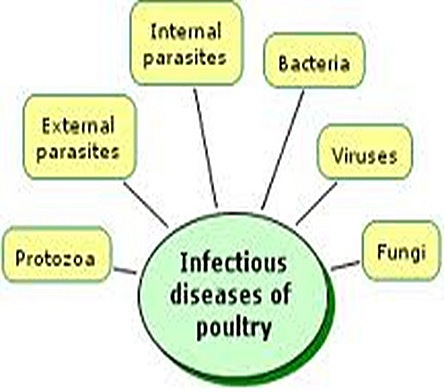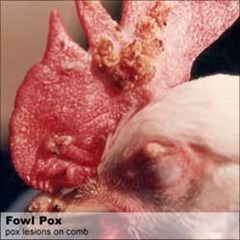Poultry-Diseases
DISEASES IN POULTRY
In the intensive system of commercial poultry farming, the birds are subjected to various types of diseases. The diseases in poultry are caused by a variety of agents. As such, the diseases are classified

I) Bacterial diseases,
II) Viral diseases,
lll) Fungal diseases,
IV) Protozoan diseases
V)Parasitic diseases and
VI) Nutritional deficiency diseases.
I. BACTERIAL DISEASES in POULTRY
A. Chronic Respiratory Disease - This is the egg transmitted disease.
2. The production of the eggs falls down in layers.
3. The symptoms of the disease are sneezing, swollen sinuses, eyes and respiratory distress, reduced body weight, etc.
4. Disease could be controlled by dipping of hatching eggs in
antibiotic solutions and giving antibiotics such as Tylosin.
B. Fowl Cholera

1. This disease is spread by the birds like crows.
2. The symptoms of the disease are
a) Greenish yellow diarrhea
b) Purplish discoloration of comb and wattles, and
c) Respiratory trouble, stop feeding.
3. Disease could be controlled by treating with sulphonamides and antibiotics.
C. Coryza
1. The disease is transmitted through water and moist litter.
2. Symptoms of the disease are coughing, sneezing, swoollen
face, breathing problem, eye lids stick together and the
discharge from the eyes and nostrils emit bad smell, reduced
feed consumption and low egg production.
3. Disease may be controlled by treating the birds with
sulphathiazole in water and feed or giving streptomycin intramuscularly.
D. Pullorum Disease in Fowls
1. This disease is caused by Salmonella pullorum to young chicken of 5-10 days.
2. The fowls themselves are the carriers of this disease.
3. The body of young chicken is moist and aggregate in groups.
4. Symptoms of the disease are . dullness, and white diarrhoea. Due to this symptom, this disease is called Bacillary white diarrhoea. Breathing problem and high mortality occur in these birds.
5. Nitroferan compounds are used to control mortality.
E. Spirochaetosis in poultry
1. This disease is caused by spirochaets.
2. The disease is transmitted by the fowl ticks, hence it can be called tick fever.
3. Symptoms of the disease are high fever, greenish diarrhoea, pale combs and wattles, increased thirst and paralysis before
death.
4. The disease may be controlled by killling ticks and giving
pencillin for the birds.
VIRAL DISEASES IN POULTRY
A. Marek’s Disease
. .
1. This is contagious disease.
2. The wings and fleck fall down. They do not drink water. Weight of the body reduces. They move away from other fowls.
3. Symptoms are paralysis and loss of vision in old birds.
4. No treatment is available but vaccination to the young chicks gives protection.
B. Ranikhet disease
1. This is also called New castle disease.
2. It is a contagious disease.
3. Symptoms are breathing problem, coughing, nasal discharge,
greenish diarrhoea and paralysis.
4. No specific treatment is available. However, mild doses of
vaccine followed by booster doses of strong vaccine reduce
the risk of disease.
C.Infectious bronchitis in Poultry
1.This is a contagious disease.
2.Symptoms are sneezing, coughing, high mortality in young ones, drop in egg production, thin shell eggs, etc.
3. No specific treatment, but mass vaccination of young chicks is effective in preventing the disease.
D.Infectious laryngotrachitis
1.This is a contagious disease which affects the older birds.
2. The symptoms are:
i. Marked respiratory problems, swelling of the face
ii. Drop in egg production and
iii. High mortality rate.
3. No definite treatment but vaccination controls the disease to some extent.
E. Fowl Fox

1. This is a mild disease effecting young chicken and layers.
2. The main symptom to identify this disease is the typical wart -like structure, skin or mouth found on the comb.
3. Breathing is difficult. It spreads through mosquitoes.
4. Vaccination is proved to be effective.
F. Gumboro Disease
1. It is infectious and effects younger birds of 4 - 8 weeks.
2. Disease spreads through feed and water.
3. Symptoms of the disease are watery diarrhoea, depression stop feeding and young ones shiver.
FUNGAL DISEASES IN POULTRY
A.Brooder Pneumonia :
This disease is also named as Aspergillosis. It is caused by a fungus, Aspergillus fumigatus. This disease spreads through litter and feed to the young ones of brooding stage.
2. Symptoms of the disease are breathing problem, gasping, inflammed eyes and high mortality.
3. No treatment is available.
B. Aflotoxicosis:
1. This disease is caused by Asperigillus flavus.
2. It spreads through contaminated litter and feed.
3. The symptoms are variable. Fall of immunity and are liable to be afected with other diseases. The egg laying capacity falls down and the fowls are destroyed.
4. It may be prevented by avoiding moisture, contaminated teed and litter.
IV. PROTOZOAN DISEASE IN POULTRY:
1. The protozoan parasite, Elmeria causes coccidiasis in fowls.
2. It spreads mostly to young ones through litter and water.
3. The symptoms are: depression, droopiness, ruffled feathers, young ones agregate in flocks, take less food and water, and
bloody diarrhoea. Mortality in these birds is severe.
4. This can be treated through water medication. Nitrofurazone and other medicines are often used.
V. PARASITIC DISEASES IN POULTRY
The diseases are caused either due to ecto parasites or endo parasites.
1. Ectoparasites Ticks, mites, lice and fleas are the common ectoparasites.
They cause generally severe irritation by biting or sucking.
They can be prevented by using insecticide like DDT.
2. Endo parasites Helminths like nematodes (round worms) cestodes (tape worms) and trematodes (flukes) are the common endo parasites. The symptoms caused by these organisms vary depending on the parasite. For treatment, the drugs like carbontetrachloride, turpentine are used.
VI. POULTRY-NUTRITIONAL DEFICIENCY DISEASES
These diseases are caused by the dificiency ot nutrients such as vitamins and minerals in the feed. For example the deficiency of vitamin E causes a disease called “Encephalomalacia” in poultry. The nutritional deficiency diseases are due to intensive method of poultry farming. They can be rectified by treating the poultry with the balanced feed.
